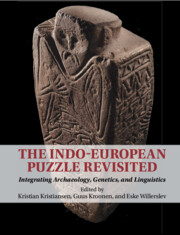Book contents
- The Indo-European Puzzle Revisited
- The Indo-European Puzzle Revisited
- Copyright page
- Contents
- Figures
- Tables
- Contributors
- Preface
- Introduction
- Part I Early Indo-European and the Origin of Pastoralism
- Part II Migratory Processes and Linguistic Dispersals between Yamnaya and the Corded Ware
- Part III The Cultural and Linguistic Significance of Bell Beakers along the Atlantic Fringe
- 9 From the Steppe to Ireland: The Impact of aDNA Research
- 10 Beaker Culture Metal and Mobility in Atlantic Europe: Some Implications for Genetic and Language Origins
- 11 “From the Ends of the Earth”: A Cross-Disciplinary Approach to Long-Distance Contact in Bronze Age Atlantic Europe
- 12 With the Back to the Ocean: The Celtic Maritime Vocabulary
- 13 European Prehistory between Celtic and Germanic: The Celto-Germanic Isoglosses Revisited
- Part IV The Bronze Age Chariot and Wool Horizons
- Part V Kinship Systems, Marriage, Fosterage, Free, and Unfree
- Concluding Reflections
- Index
- References
10 - Beaker Culture Metal and Mobility in Atlantic Europe: Some Implications for Genetic and Language Origins
from Part III - The Cultural and Linguistic Significance of Bell Beakers along the Atlantic Fringe
Published online by Cambridge University Press: 29 April 2023
- The Indo-European Puzzle Revisited
- The Indo-European Puzzle Revisited
- Copyright page
- Contents
- Figures
- Tables
- Contributors
- Preface
- Introduction
- Part I Early Indo-European and the Origin of Pastoralism
- Part II Migratory Processes and Linguistic Dispersals between Yamnaya and the Corded Ware
- Part III The Cultural and Linguistic Significance of Bell Beakers along the Atlantic Fringe
- 9 From the Steppe to Ireland: The Impact of aDNA Research
- 10 Beaker Culture Metal and Mobility in Atlantic Europe: Some Implications for Genetic and Language Origins
- 11 “From the Ends of the Earth”: A Cross-Disciplinary Approach to Long-Distance Contact in Bronze Age Atlantic Europe
- 12 With the Back to the Ocean: The Celtic Maritime Vocabulary
- 13 European Prehistory between Celtic and Germanic: The Celto-Germanic Isoglosses Revisited
- Part IV The Bronze Age Chariot and Wool Horizons
- Part V Kinship Systems, Marriage, Fosterage, Free, and Unfree
- Concluding Reflections
- Index
- References
Summary
The importance of metal for an understanding of the international Beaker culture is well established, whether as a driver of trade connections and other forms of exchange, or as a material expression of ethnicity, ideology, or social relations. While copper and gold were used in earlier times in Europe, Beaker groups can be associated with a spread of metallurgical knowledge across the Atlantic zone during the later third millennium BC. This chapter will consider long-distance networks of metal production and supply in relation to the mobility of the Beaker culture. The nature of those connections will be explored, whether they involved migration of ethnic groups or the small-scale movement of specialists, their ideas and material culture, through trade and other forms of exchange. The implications for genetic and language origins will be considered, with a focus on connections between Iberia, France, and Ireland in that period.
- Type
- Chapter
- Information
- The Indo-European Puzzle RevisitedIntegrating Archaeology, Genetics, and Linguistics, pp. 146 - 156Publisher: Cambridge University PressPrint publication year: 2023



